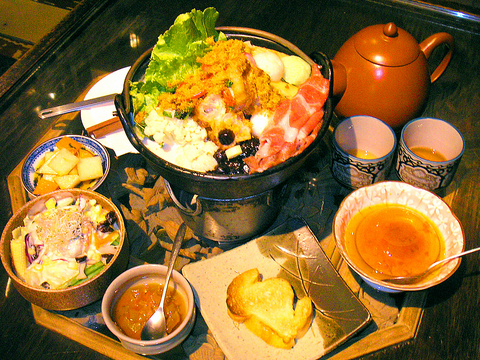Remember the scene of the battle in the bamboo forest in Crouching Tiger, Hidden Dragon? The Moonlight Tea House (
Walk past the willow tree outside the Moonlight Tea House and you are welcomed into a time machine -- you can eat the way it was 1,000 years ago in Tang Dynasty, sitting on the floor, appreciating paintings from the royal court.
Tables are separated from each other by gauze partitions, which provides a sense of privacy. The place is good for relaxing, meditating, or having a deep talk with your friends. The restroom is decorated as though it were a garden.

PHOTOT: GINGER YANG, TAIPEI TIMES
The Moonlight Tea House is famous for its milk tea hotpot (NT$450). Instead of regular soup made from meat and
vegetables, milk tea is used as the stock. Naturally, no milk tea hotpot would be complete without tapioca balls, but the hotpot also comes with all the usual hotpot trappings. The addition of fried dough sticks and fish floss is an added extra. Such departures from convention make this a dish that customers either love or hate: it is definitely not for the faint hearted.
Another tea-based hotpot is the leicha (
Given its name, it is no surprise that in addition to hotpots, the establishment also specializes in quality teas, and is a mecca for Japanese tourists seeking to experience the Chinese version of the tea ceremony. Moonlight Tea House has specially trained waiters who will assist at the tea ceremony for a fee of NT$100 per head.
Top quality teas grown at high altitudes are highly recommended at Moonlight Tea House, though they do not come cheap. Waiters will direct patrons on how to appreciate the five separate flavors that can be found in high mountain Oolong as the temperature of the water changes. A pot of this tea will set you back NT$700 (enough for three or four).
You don't have to be a high roller though to enjoy quality tea here. A basic pot of rosy lee for one is NT$150.
The tea house is also a point of interest for collectors of teapots. One of the most expensive on display, from the Qing Dynasty, costs more than NT$1 million. You can also enjoy Chinese Zither (guzheng,

June 2 to June 8 Taiwan’s woodcutters believe that if they see even one speck of red in their cooked rice, no matter how small, an accident is going to happen. Peng Chin-tian (彭錦田) swears that this has proven to be true at every stop during his decades-long career in the logging industry. Along with mining, timber harvesting was once considered the most dangerous profession in Taiwan. Not only were mishaps common during all stages of processing, it was difficult to transport the injured to get medical treatment. Many died during the arduous journey. Peng recounts some of his accidents in

“Why does Taiwan identity decline?”a group of researchers lead by University of Nevada political scientist Austin Wang (王宏恩) asked in a recent paper. After all, it is not difficult to explain the rise in Taiwanese identity after the early 1990s. But no model predicted its decline during the 2016-2018 period, they say. After testing various alternative explanations, Wang et al argue that the fall-off in Taiwanese identity during that period is related to voter hedging based on the performance of the Democratic Progressive Party (DPP). Since the DPP is perceived as the guardian of Taiwan identity, when it performs well,

The Taiwan People’s Party (TPP) on May 18 held a rally in Taichung to mark the anniversary of President William Lai’s (賴清德) inauguration on May 20. The title of the rally could be loosely translated to “May 18 recall fraudulent goods” (518退貨ㄌㄨㄚˋ!). Unlike in English, where the terms are the same, “recall” (退貨) in this context refers to product recalls due to damaged, defective or fraudulent merchandise, not the political recalls (罷免) currently dominating the headlines. I attended the rally to determine if the impression was correct that the TPP under party Chairman Huang Kuo-Chang (黃國昌) had little of a

A short walk beneath the dense Amazon canopy, the forest abruptly opens up. Fallen logs are rotting, the trees grow sparser and the temperature rises in places sunlight hits the ground. This is what 24 years of severe drought looks like in the world’s largest rainforest. But this patch of degraded forest, about the size of a soccer field, is a scientific experiment. Launched in 2000 by Brazilian and British scientists, Esecaflor — short for “Forest Drought Study Project” in Portuguese — set out to simulate a future in which the changing climate could deplete the Amazon of rainfall. It is